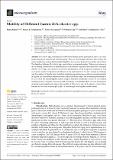Motility of Different Gastric Helicobacter spp.
Author(s)
Bansil, Rama; Constantino, Maira A.; Su-Arcaro, Clover; Liao, Wentian; Shen, Zeli; Fox, James G.; ... Show more Show less
Downloadmicroorganisms-11-00634-v2.pdf (2.699Mb)
Publisher with Creative Commons License
Publisher with Creative Commons License
Creative Commons Attribution
Terms of use
Metadata
Show full item recordAbstract
<i>Helicobacter</i> spp., including the well-known human gastric pathogen <i>H. pylori</i>, can cause gastric diseases in humans and other mammals. They are Gram-negative bacteria that colonize the gastric epithelium and use their multiple flagella to move across the protective gastric mucus layer. The flagella of different <i>Helicobacter</i> spp. vary in their location and number. This review focuses on the swimming characteristics of different species with different flagellar architectures and cell shapes. All <i>Helicobacter</i> spp. use a run-reverse-reorient mechanism to swim in aqueous solutions, as well as in gastric mucin. Comparisons of different strains and mutants of <i>H. pylori</i> varying in cell shape and the number of flagella show that their swimming speed increases with an increasing number of flagella and is somewhat enhanced with a helical cell body shape. The swimming mechanism of <i>H. suis</i>, which has bipolar flagella, is more complex than that of unipolar <i>H. pylori. H. suis</i> exhibits multiple modes of flagellar orientation while swimming. The pH-dependent viscosity and gelation of gastric mucin significantly impact the motility of <i>Helicobacter</i> spp. In the absence of urea, these bacteria do not swim in mucin gel at pH < 4, even though their flagellar bundle rotates.
Date issued
2023-03-01Department
Massachusetts Institute of Technology. Department of Biological Engineering; Picower Institute for Learning and MemoryPublisher
Multidisciplinary Digital Publishing Institute
Citation
Microorganisms 11 (3): 634 (2023)
Version: Final published version